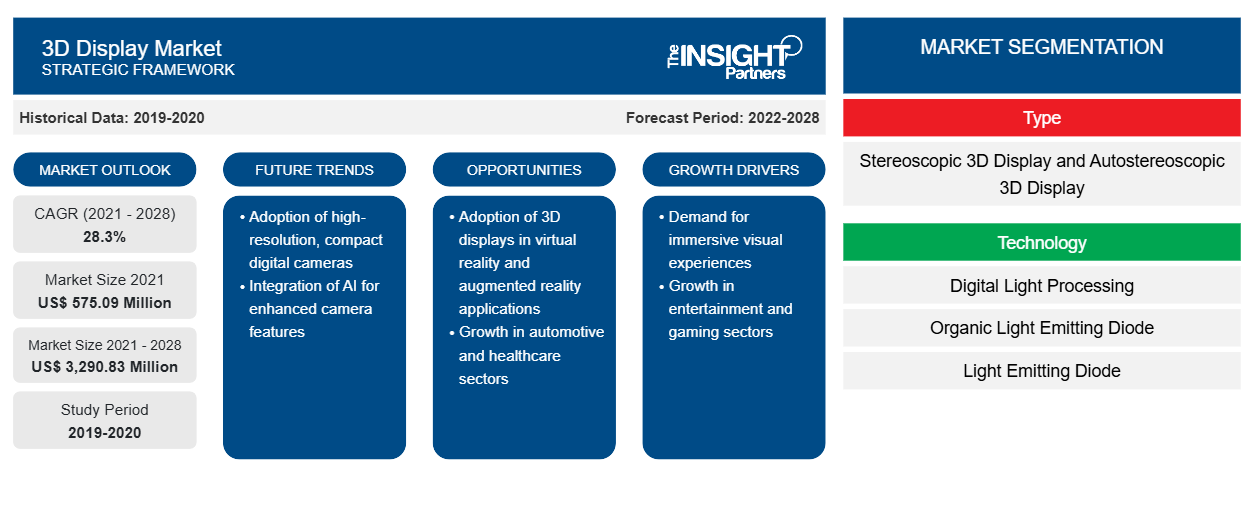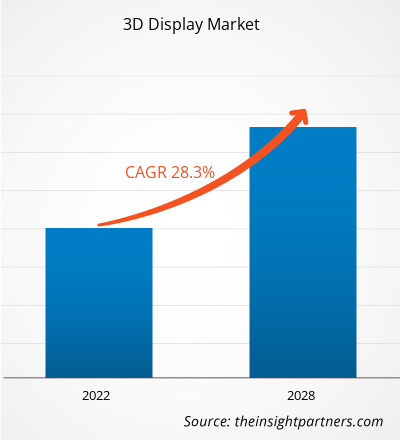2021 年 3D 显示器市场价值为 5.7509 亿美元,到 2028 年将达到 32.9083 亿美元;预计 2021 年至 2028 年的复合年增长率为 28.3%。
消费电子、汽车、医疗、军事和国防、工业、媒体和娱乐、游戏都是 3D 显示器的潜在市场。此外,娱乐和游戏行业的增长对 3D 显示器市场产生了积极影响,因为电影院屏幕数量大幅增加,即 2021 年全球约有 125,000 块电影院屏幕开始在数字平台上运营。此外,增强现实在各种医疗应用中的日益普及,以提高外科医生的视觉能力、减少手术时间和术前规划,为 3D显示器市场创造了机会。例如,2020 年 5 月,Ocutrx Vision Technologies, LLC 宣布开发其新的手术可视化影院“Ocutrx OR-Bot”,该影院配备了 3D 8K 显示器来操作手术工具。然而,推动全球 3D 显示市场增长的因素包括持续投资(尤其是在自动立体 3D 显示解决方案方面),以及市场参与者和最终用户之间越来越多的合作伙伴关系,以开发适用于广泛应用的先进全息和体积 3D 显示系统。
定制此报告以满足您的需求
您可以免费定制任何报告,包括本报告的部分内容、国家级分析、Excel 数据包,以及为初创企业和大学提供优惠和折扣
- 获取此报告的关键市场趋势。这个免费样品将包括数据分析,从市场趋势到估计和预测。
COVID-19 疫情对 3D 显示市场的影响
COVID-19 危机影响了全球各行各业,全球经济在 2020 年遭受了最严重的打击,这种情况很可能持续到 2021 年。疫情对汽车、零售和消费电子等主要行业造成了严重破坏。电子和制造业的急剧下滑正在影响全球 3D 显示器市场的增长。北美是采用和发展新技术最有利的地区之一,因为北美政府出台了支持创新的政策,拥有庞大的工业基础和高购买力,尤其是在美国和加拿大等发达国家。北美拥有大量制造业和科技公司,因此到 2021 年中期,COVID-19 疫情的影响相当严重。随着 COVID-19 疫苗接种运动的开展,该地区预计市场将复苏,经济将改善。
市场洞察 – 3D 显示市场
行业合作伙伴数量不断增加,推动市场增长
目前 3D 显示器的主要应用领域是营销和广告领域。医疗、汽车和国防预计将成为 3D 显示器的潜在领域。根据市场积极增长和技术发展,3D 显示技术的潜在应用领域数量可能空前。
基于类型的洞察
根据类型,3D 显示器市场分为立体 3D 显示器和自动立体 3D 显示器。自动立体 3D 显示器部分在 2021 年占据了更大的市场份额。
3D显示市场的参与者主要致力于开发先进、高效的产品。
- 2021年4月,友达于Touch Taiwan 2021展出惊艳的ALED显示器系列,展示全球领先的Micro LED技术与应用。
- 2021年9月,三星的可拉伸显示屏可以将2D内容转变为移动的3D场景。
3D 显示市场区域洞察
Insight Partners 的分析师已详尽解释了预测期内影响 3D 显示器市场的区域趋势和因素。本节还讨论了北美、欧洲、亚太地区、中东和非洲以及南美和中美洲的 3D 显示器市场细分和地理位置。

- 获取 3D 显示市场的区域特定数据
3D 显示市场报告范围
| 报告属性 | 细节 |
|---|---|
| 2021 年市场规模 | 5.7509亿美元 |
| 2028 年市场规模 | 32.9083亿美元 |
| 全球复合年增长率(2021 - 2028) | 28.3% |
| 史料 | 2019-2020 |
| 预测期 | 2022-2028 |
| 涵盖的领域 | 按类型
|
| 覆盖地区和国家 | 北美
|
| 市场领导者和主要公司简介 |
|
市场参与者密度:了解其对商业动态的影响
3D 显示器市场正在快速增长,这得益于终端用户需求的不断增长,而这些需求又源于消费者偏好的不断变化、技术进步以及对产品优势的认识不断提高等因素。随着需求的增加,企业正在扩大其产品范围,进行创新以满足消费者的需求,并利用新兴趋势,从而进一步推动市场增长。
市场参与者密度是指在特定市场或行业内运营的企业或公司的分布情况。它表明在给定市场空间中,相对于其规模或总市场价值,有多少竞争对手(市场参与者)存在。
在 3D 显示市场运营的主要公司有:
- 友达光电股份有限公司
- 群创光电
- LG 电子
- 三菱电机公司
- 松下公司
免责声明:上面列出的公司没有按照任何特定顺序排列。

- 获取 3D 显示市场顶级关键参与者概览
3D 显示器市场细分为类型、技术、应用和地理区域。根据类型,市场细分为立体 3D 显示器和自动立体 3D 显示器。2021 年,自动立体 3D 显示器细分市场引领 3D 显示器市场并占据最大市场份额。根据技术,市场分为数字光处理、有机发光二极管和发光二极管。2021 年,数字光处理细分市场引领 3D 显示器市场并占据最大市场份额。根据应用,市场细分为消费电子、汽车、医疗、广告、零售、军事和国防等。2021 年,消费电子细分市场引领 3D 显示器市场并占据最大市场份额。从地理区域来看,市场大致分为北美、欧洲、亚太地区 (APAC)、中东和非洲 (MEA) 和南美 (SAM)。 2021年,北美在全球市场中占有相当大的份额。
全球 3D 显示市场的一些主要供应商包括友达光电股份有限公司、群创光电股份有限公司、LG 电子、三菱电机股份有限公司、松下电器股份有限公司、三星集团、夏普株式会社、Looking Glass Factory Inc、Light Field Lab Inc、Leia Inc、索尼、东芝株式会社和富士胶片株式会社等公司。
- 历史分析(2 年)、基准年、预测(7 年)及复合年增长率
- PEST 和 SWOT 分析
- 市场规模价值/数量 - 全球、区域、国家
- 行业和竞争格局
- Excel 数据集


- Biopharmaceutical Tubing Market
- Sandwich Panel Market
- Nuclear Decommissioning Services Market
- Hydrogen Compressors Market
- Clinical Trial Supplies Market
- Trade Promotion Management Software Market
- Artwork Management Software Market
- Hydrogen Storage Alloys Market
- Energy Recovery Ventilator Market
- Dry Eye Products Market

Report Coverage
Revenue forecast, Company Analysis, Industry landscape, Growth factors, and Trends

Segment Covered
This text is related
to segments covered.

Regional Scope
North America, Europe, Asia Pacific, Middle East & Africa, South & Central America

Country Scope
This text is related
to country scope.
常见问题
The 3D display have been in use for several years worldwide, however, the technology has been experiencing immense demand in recent years. Potential applications of advanced 3d display technologies in end-user industries is supporting the growth of 3D display market.
The major companies in 3D display includes Samsung, AU Optronics Corp., HYPERVSN, LEIA INC., and Holografika. The ranking has been derived analysing multiple parameters such as annual revenue earned from 3D display portfolio, client base, geographic locations, R&D expenditure, brand image, and number of employees, among others. These companies are actively participating in developing 3D display for various applications.
The present 3D display market is in its nascent stages of growth cycle and companies operating in this market are investing heavily in research and development to bring successful 3D display systems to the commercial market. Medical, automotive, and defense are expected to be some of the largest growth potential areas for the demand of 3D displays worldwide. The prospective application areas of 3D display technologies could be unprecedented in number depending on the positive growth and technology development in the market.
US held the largest share in North America region. The US is a technologically advanced country that adopts technologies at an early phase. The rising number of 3D cinemas, increasing penetration of smart TVs and digital video games users, and others are expected to drive the market growth. Moreover, the increasing demand for 3D display technology is rising in the defense industry due to its wide adoption in creating awareness in education and battlefield monitoring applications.
The global 3D display market was dominated by autostereoscopic 3D display segment accounted for the largest share in 2021 and the testing services segment is anticipated to be one of the fastest growing segments during the forecast period. The autostereoscopic 3D display segment is anticipated to flourish during the forecast period, owing to the benefits of viewing 3D content without the use of special hardware, coupled with growing need for creating impressive and profound experience to reach the target audience, and increasing investment and product development by market players.
In 2021, North America led the market with a substantial revenue share, followed by APAC and Europe. The rising adoption of innovative technologies for movies has been immensely increased in the region. The media & entertainment industry is looking forward to implementing glasses-free 3D technology for enhanced consumer experience. For instance, the Oscar-winning movie “Avatar†was made in 3D; it has broken the box-office records. Back then, the movie was viewed with 3D glasses.
Trends and growth analysis reports related to Electronics and Semiconductor : READ MORE..
The List of Companies - 3D Display Market
- AU OPTRONICS CORP
- Innolux Corporation
- LG Electronics
- Mitsubishi Electric Corporation
- Panasonic Corporation
- Samsung Group
- Sharp Corporation
- Looking Glass Factory Inc
- Light Field Lab, Inc
- Leia Inc
- Sony Corporation
- Toshiba Corporation
- Fujifilm Corporation
- BOE Technology Group
The Insight Partners performs research in 4 major stages: Data Collection & Secondary Research, Primary Research, Data Analysis and Data Triangulation & Final Review.
- Data Collection and Secondary Research:
As a market research and consulting firm operating from a decade, we have published and advised several client across the globe. First step for any study will start with an assessment of currently available data and insights from existing reports. Further, historical and current market information is collected from Investor Presentations, Annual Reports, SEC Filings, etc., and other information related to company’s performance and market positioning are gathered from Paid Databases (Factiva, Hoovers, and Reuters) and various other publications available in public domain.
Several associations trade associates, technical forums, institutes, societies and organization are accessed to gain technical as well as market related insights through their publications such as research papers, blogs and press releases related to the studies are referred to get cues about the market. Further, white papers, journals, magazines, and other news articles published in last 3 years are scrutinized and analyzed to understand the current market trends.
- Primary Research:
The primarily interview analysis comprise of data obtained from industry participants interview and answers to survey questions gathered by in-house primary team.
For primary research, interviews are conducted with industry experts/CEOs/Marketing Managers/VPs/Subject Matter Experts from both demand and supply side to get a 360-degree view of the market. The primary team conducts several interviews based on the complexity of the markets to understand the various market trends and dynamics which makes research more credible and precise.
A typical research interview fulfils the following functions:
- Provides first-hand information on the market size, market trends, growth trends, competitive landscape, and outlook
- Validates and strengthens in-house secondary research findings
- Develops the analysis team’s expertise and market understanding
Primary research involves email interactions and telephone interviews for each market, category, segment, and sub-segment across geographies. The participants who typically take part in such a process include, but are not limited to:
- Industry participants: VPs, business development managers, market intelligence managers and national sales managers
- Outside experts: Valuation experts, research analysts and key opinion leaders specializing in the electronics and semiconductor industry.
Below is the breakup of our primary respondents by company, designation, and region:

Once we receive the confirmation from primary research sources or primary respondents, we finalize the base year market estimation and forecast the data as per the macroeconomic and microeconomic factors assessed during data collection.
- Data Analysis:
Once data is validated through both secondary as well as primary respondents, we finalize the market estimations by hypothesis formulation and factor analysis at regional and country level.
- Macro-Economic Factor Analysis:
We analyse macroeconomic indicators such the gross domestic product (GDP), increase in the demand for goods and services across industries, technological advancement, regional economic growth, governmental policies, the influence of COVID-19, PEST analysis, and other aspects. This analysis aids in setting benchmarks for various nations/regions and approximating market splits. Additionally, the general trend of the aforementioned components aid in determining the market's development possibilities.
- Country Level Data:
Various factors that are especially aligned to the country are taken into account to determine the market size for a certain area and country, including the presence of vendors, such as headquarters and offices, the country's GDP, demand patterns, and industry growth. To comprehend the market dynamics for the nation, a number of growth variables, inhibitors, application areas, and current market trends are researched. The aforementioned elements aid in determining the country's overall market's growth potential.
- Company Profile:
The “Table of Contents” is formulated by listing and analyzing more than 25 - 30 companies operating in the market ecosystem across geographies. However, we profile only 10 companies as a standard practice in our syndicate reports. These 10 companies comprise leading, emerging, and regional players. Nonetheless, our analysis is not restricted to the 10 listed companies, we also analyze other companies present in the market to develop a holistic view and understand the prevailing trends. The “Company Profiles” section in the report covers key facts, business description, products & services, financial information, SWOT analysis, and key developments. The financial information presented is extracted from the annual reports and official documents of the publicly listed companies. Upon collecting the information for the sections of respective companies, we verify them via various primary sources and then compile the data in respective company profiles. The company level information helps us in deriving the base number as well as in forecasting the market size.
- Developing Base Number:
Aggregation of sales statistics (2020-2022) and macro-economic factor, and other secondary and primary research insights are utilized to arrive at base number and related market shares for 2022. The data gaps are identified in this step and relevant market data is analyzed, collected from paid primary interviews or databases. On finalizing the base year market size, forecasts are developed on the basis of macro-economic, industry and market growth factors and company level analysis.
- Data Triangulation and Final Review:
The market findings and base year market size calculations are validated from supply as well as demand side. Demand side validations are based on macro-economic factor analysis and benchmarks for respective regions and countries. In case of supply side validations, revenues of major companies are estimated (in case not available) based on industry benchmark, approximate number of employees, product portfolio, and primary interviews revenues are gathered. Further revenue from target product/service segment is assessed to avoid overshooting of market statistics. In case of heavy deviations between supply and demand side values, all thes steps are repeated to achieve synchronization.
We follow an iterative model, wherein we share our research findings with Subject Matter Experts (SME’s) and Key Opinion Leaders (KOLs) until consensus view of the market is not formulated – this model negates any drastic deviation in the opinions of experts. Only validated and universally acceptable research findings are quoted in our reports.
We have important check points that we use to validate our research findings – which we call – data triangulation, where we validate the information, we generate from secondary sources with primary interviews and then we re-validate with our internal data bases and Subject matter experts. This comprehensive model enables us to deliver high quality, reliable data in shortest possible time.


 获取此报告的免费样本
获取此报告的免费样本